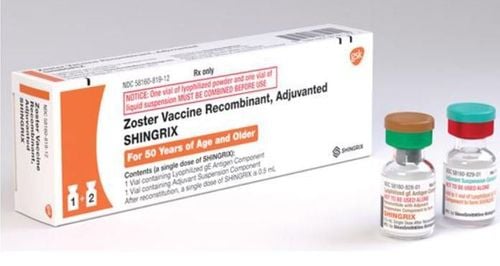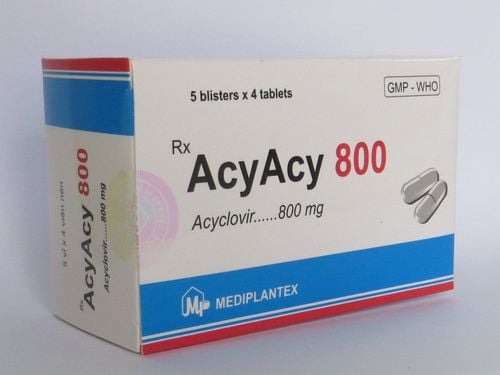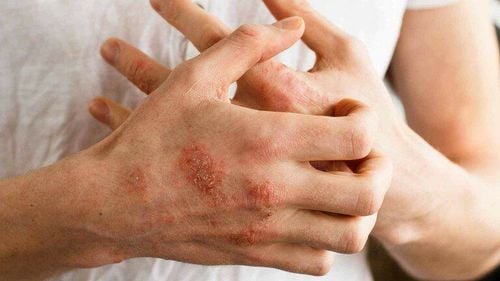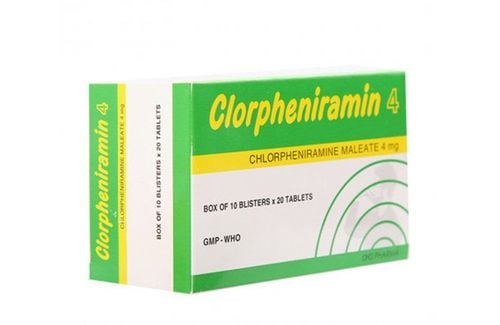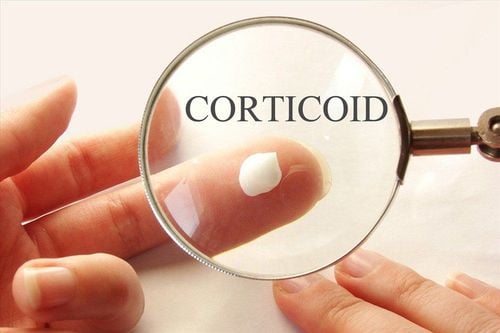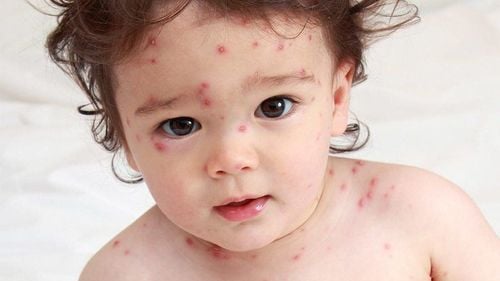This is an automatically translated article.
Blisters are common in people of all ages and can be caused by a lot of different things. Finding the cause and treating it according to the cause can best help improve the disease.
1. What are blisters?
Blisters are small, fluid-filled nodules under the top layer of your skin, these blisters are usually less than 5mm in size. They may be filled with pus, blood, or serum.
Depending on the cause of your blisters it may be accompanied by other symptoms such as itching or pain more or less. They may appear as single blisters or form clusters.
Blisters can appear anywhere on the body but are more common on the hands or feet. Their properties are very fragile and cause the fluid to flow out, after the fluid dries, it can leave a yellow scab on the skin. However, when blisters burst, if not cared for properly, they can become infected.
2. Causes of Blisters
There are many causes of blisters including:
Friction Blisters can be caused by friction, this is one of the most common types of blisters. You may see blisters appear due to wearing gloves, shoes, boots... for a long time. Those are the things that can cause friction blisters on your heels, toes, thumbs, or palms. These blisters can go away on their own after a while, but you should limit the wearing of items that cause friction to avoid further damage.
Due to temperature Some cases of not wearing gloves in winter can cause blistering due to frostbite or similar can also occur if handling frozen items. High temperatures such as prolonged exposure to the sun or touching objects that are too hot can also cause blisters. Thus, both cold and heat cause blisters on the skin because sudden temperature changes can damage the skin.
Contact dermatitis Contact dermatitis has two forms: irritant and allergic dermatitis. Irritant dermatitis encountered when contacting a plant such as poison ivy, body fluids of three compartment ants... are all causes of blisters. Allergic contact dermatitis is usually a symptom that occurs when you touch something you are allergic to and which is not necessarily poisonous, for example soaps, perfumes, detergents, fabrics, furniture jewelry, belts, leather purses, rubber gloves, or things used to make toys or other everyday items.
Atopic Dermatitis Also known as eczema, this condition usually presents as small, clear fluid-filled blisters. Scratching a lot of eczema can cause a superinfection that causes these pus-filled blisters on the palms of your hands and soles of your feet. If you think you may have infectious eczema, seek medical care. In addition, to reduce itching can use topical creams containing antihistamines, moisturizers ...
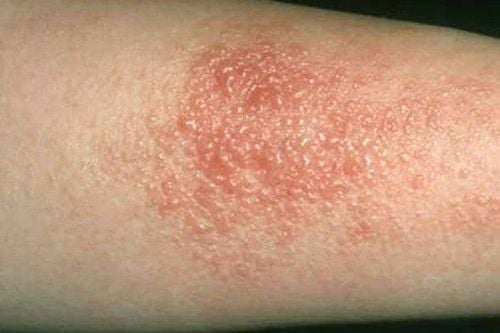
Viêm da dị ứng là một trong các nguyên nhân gây mụn nước
Insect bites Insects can cause blisters and are often accompanied by itching. Scabies is one of the parasites that cause blisters through their tunnels and are very itchy, scabies usually attacks the hands, feet, wrists and under the arms and then spreads. to another area. Flea and bed bug bites can also cause small blisters. Brown spiders can also bite and cause extreme discomfort, often blistering before exacerbating a painful open sore. If in this case you find that these insects are caused, you need to go to a medical facility for early treatment.
Chickenpox and Shingles Chickenpox and shingles are caused by the same virus. Initially, the patient can be infected with chickenpox through the respiratory tract when in contact with other patients, when infected, the patient is often tired, sore throat, fever and red blisters that turn into blisters, then scabs. If you've had chickenpox, then you may also have shingles, which targets the nerves and causes a painful rash with blisters. The Centers for Disease Control and Prevention recommends that people 60 years of age and older get vaccinated once to prevent shingles, because older age has a higher risk of developing painful complications, so take precautions. When suffering from both diseases, you should go to a medical facility early to receive drug treatment and appropriate care instructions.
Herpes Simplex Fever, accompanied by blisters on the lips, mouth or genitals in clusters is a sign of the herpes simplex virus. The fluid in these sores carries and spreads the virus through sex, kissing, or sharing utensils. Many people don't know they have these blisters because the symptoms are usually mild and go away on their own. There is no cure for this disease completely, because the virus is still in the body. But certain medications can stop or quickly relieve symptoms during flare-ups.
Hand, foot and mouth disease This disease is named after the blisters it causes on different parts of the body. The disease is highly contagious and mainly affects children under 10 years of age. The hand, foot and mouth disease virus is spread by contact with the mucus, saliva, stool, or blisters of an infected person. Hand, foot and mouth disease begins with a low-grade fever, runny nose, and sore throat. The subsequent appearance of blisters on the hands, feet, and inside the mouth makes it easier to diagnose. Taking care of symptoms can help the disease heal faster.
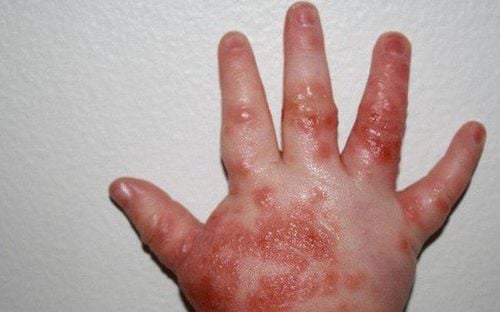
Nguyên nhân gây mụn nước có thể do bệnh tay chân miệng gây ra
3. How to treat blisters
Blisters on the skin are mostly caused by non-dangerous causes. Therefore, it will usually heal on its own with proper care. Some measures to help care and treat blisters include:
If blisters are caused by some causes such as contact dermatitis, eczema, dangerous insects, scabies, you need to visit a medical facility. for proper treatment. As with scabies, which kills the parasites, scabies requires antibiotics... Keep the pimple clean and dry: A circular pad or tape can be used to keep it from bursting. Some ways to increase moisture for the skin with blisters: You can use moisturizers or herbs such as aloe vera, coconut oil... country. Try to reduce the feeling of wanting to burst these blisters: If it doesn't affect your life, don't pop it. But if the pimple is so large or painful that you can't walk or work, see your doctor, who may decide to puncture with a sterile needle to allow the fluid to drain. After the wound has peeled off gently wash the area with soap and water, antibiotic ointment should be applied. Cover the wound with a bandage to keep it clean during the day, but remove it at night to allow the wound to dry. Washing the area with blisters with warm salt water is a method that both helps reduce swelling and removes some harmful factors on the skin such as bacteria and fungi. Helps limit blisters infected with pathogenic bacteria. Equip with safety protective equipment such as gloves and boots in case you need to be exposed to irritating factors. Helps protect the skin from the harmful effects of this agent on direct contact. To prevent acne caused by friction, you should limit the use of items that are too tight and frequent. Or use cotton or talcum powder to reduce friction. The diet should reduce foods high in fat and increase green vegetables and fruits. Helps to supplement the amount of nutrients needed by the body, thereby helping to strengthen the immune system against pathogens.
4. When to see a doctor
In some cases of blisters you need to see a doctor if accompanied by symptoms such as:
When blisters are accompanied by fever, chills or flu-like symptoms. By this case you may be infected with a certain virus or infection. Other symptoms of an infection may include: Feeling very sore, swollen, red, or hot, red streaks oozing from your blister, or pus draining from the blister. Blisters that appear around the eyes or on the genitals are also a cause for concern that should be examined and treated. The above are common causes of blisters and appropriate care. However, if you feel worried or have severe skin symptoms or symptoms, go to a medical facility for the most appropriate examination and treatment.
Please dial HOTLINE for more information or register for an appointment HERE. Download MyVinmec app to make appointments faster and to manage your bookings easily.
Reference source: webmd.com



